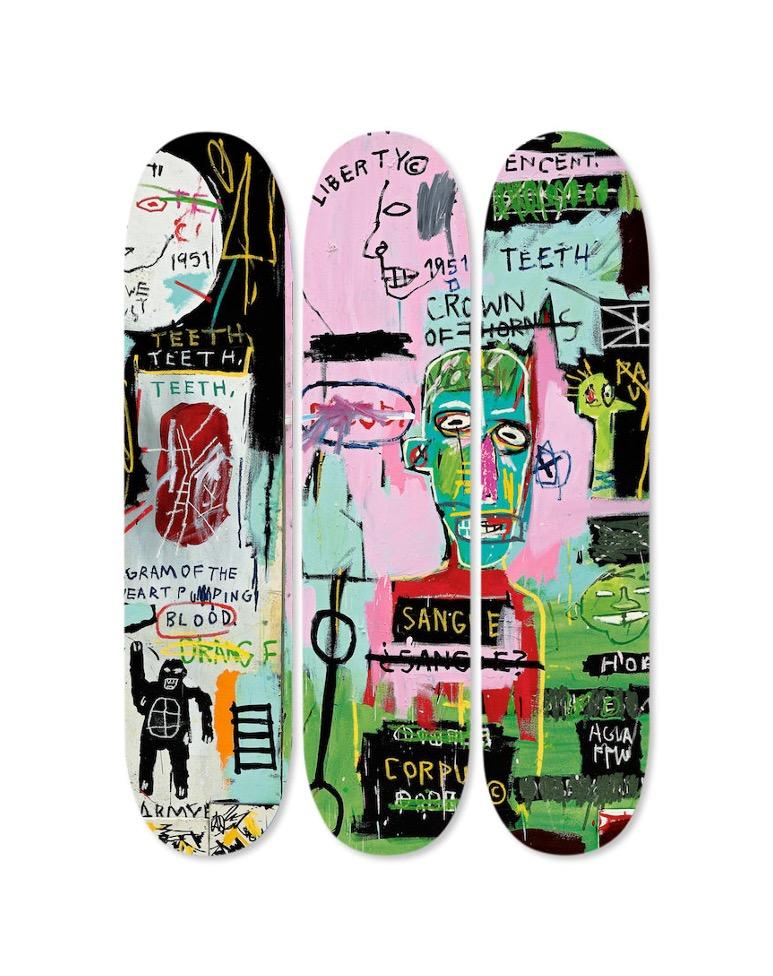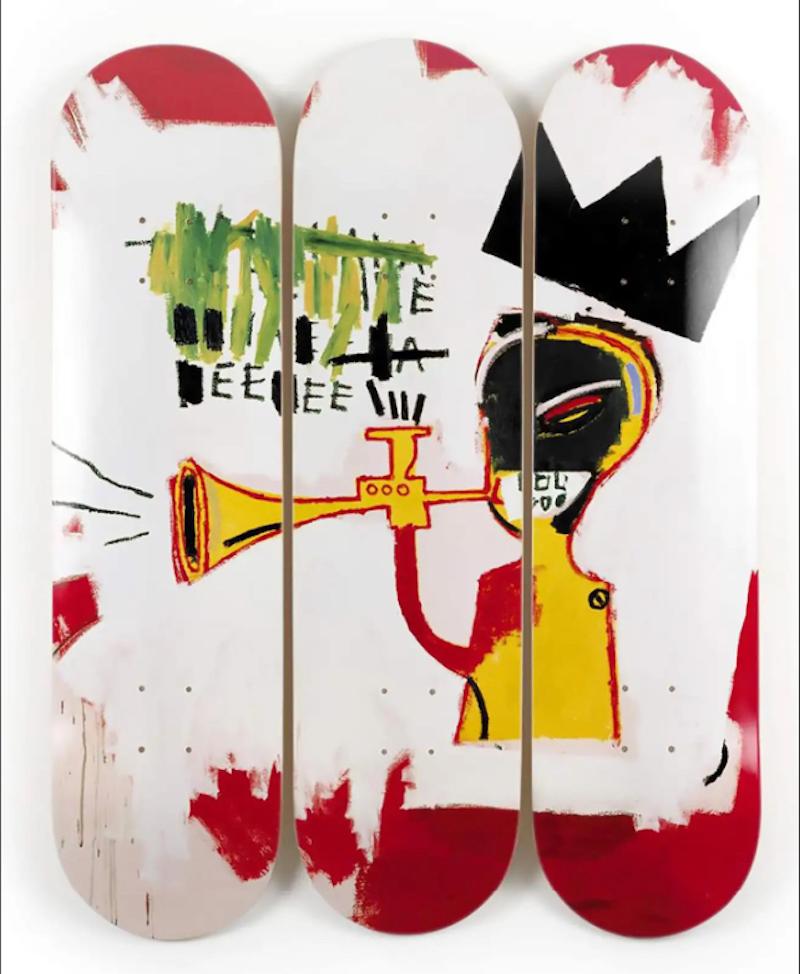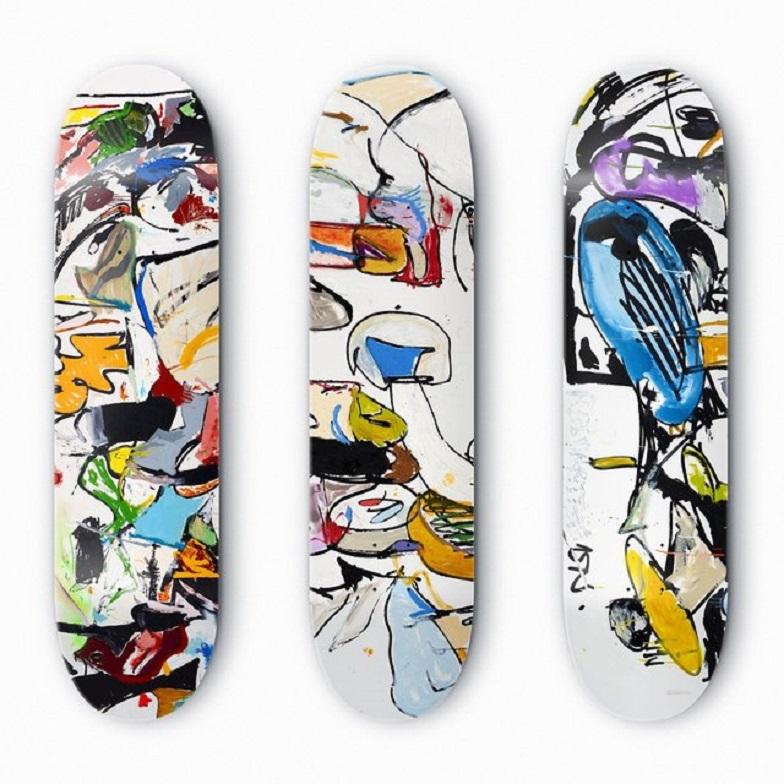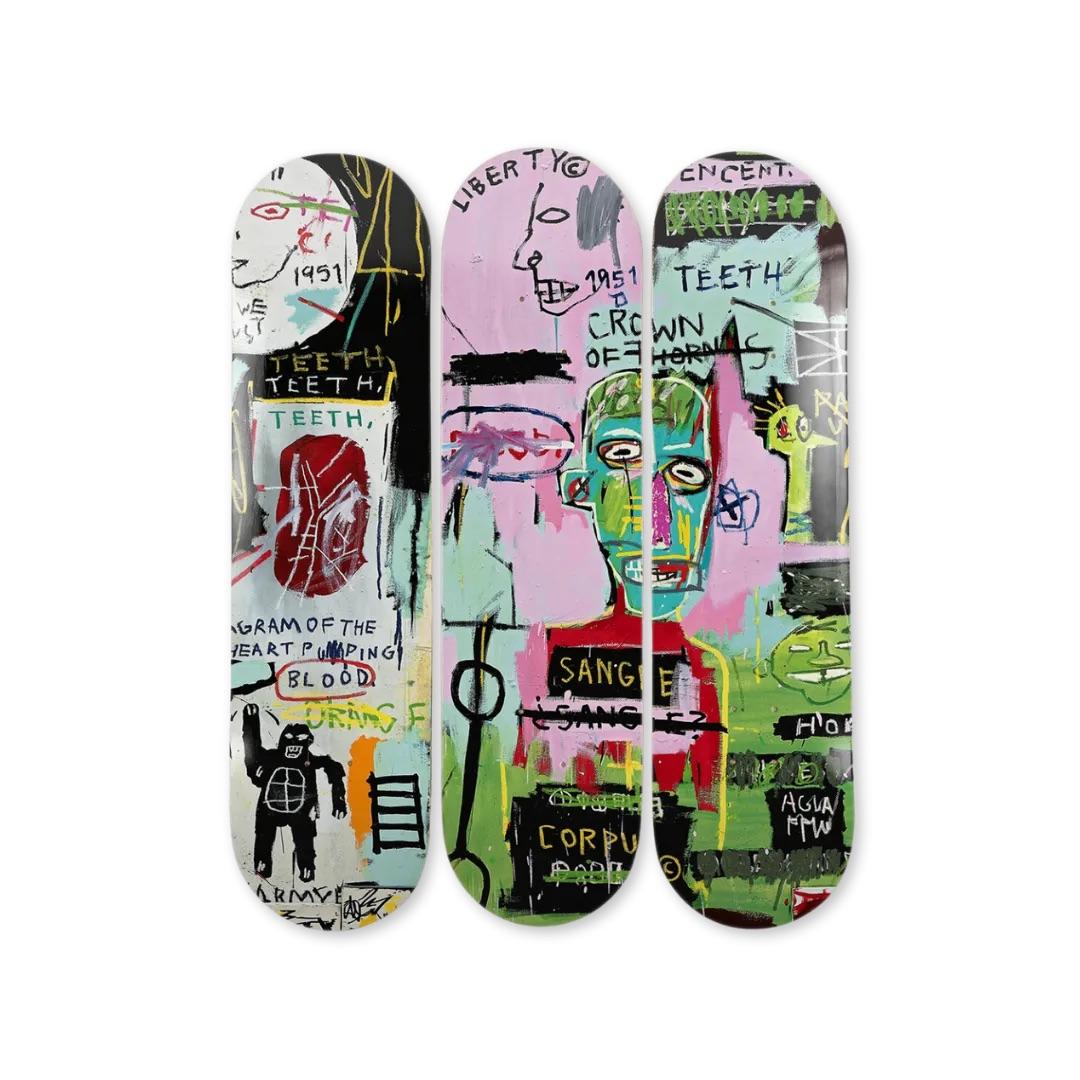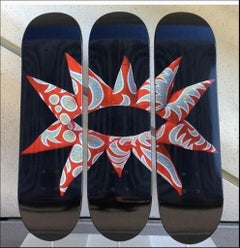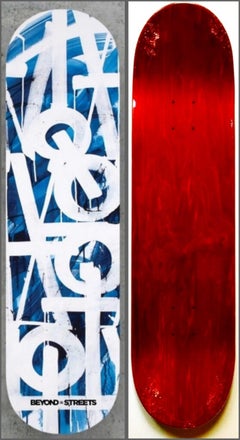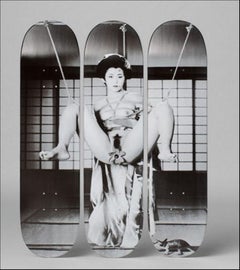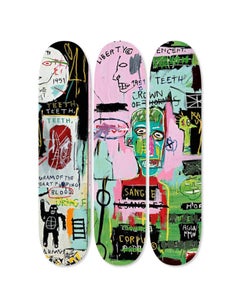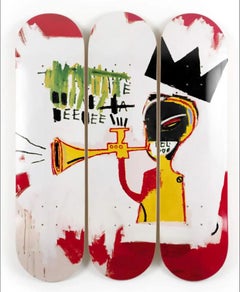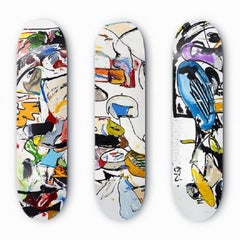Items Similar to ROBOT Triptych (Set of Three (3) Skateboards)
Want more images or videos?
Request additional images or videos from the seller
1 of 5
ROBOT Triptych (Set of Three (3) Skateboards)2017
2017
$2,800
£2,170.38
€2,468.57
CA$4,012.82
A$4,399.94
CHF 2,300.17
MX$52,697.77
NOK 29,016.10
SEK 27,217.11
DKK 18,441.76
About the Item
The Skateroom x Estate of Jean-Michel Basquiat
ROBOT Triptych (Set of Three (3) Skateboards), 2017
Set of 3 Silkscreens on 7-Ply Canadian Maplewood Skate Decks (Set of 3)
Estate of Jean-Michel Basquiat copyright and printed signature on the back
31 × 8 inches
Unframed
Excellent condition; measurements apply to each skate board. Brand new.
About the Seller
5.0
Platinum Seller
Premium sellers with a 4.7+ rating and 24-hour response times
Established in 2007
1stDibs seller since 2022
458 sales on 1stDibs
Typical response time: 2 hours
- ShippingRetrieving quote...Shipping from: New York, NY
- Return Policy
Authenticity Guarantee
In the unlikely event there’s an issue with an item’s authenticity, contact us within 1 year for a full refund. DetailsMoney-Back Guarantee
If your item is not as described, is damaged in transit, or does not arrive, contact us within 7 days for a full refund. Details24-Hour Cancellation
You have a 24-hour grace period in which to reconsider your purchase, with no questions asked.Vetted Professional Sellers
Our world-class sellers must adhere to strict standards for service and quality, maintaining the integrity of our listings.Price-Match Guarantee
If you find that a seller listed the same item for a lower price elsewhere, we’ll match it.Trusted Global Delivery
Our best-in-class carrier network provides specialized shipping options worldwide, including custom delivery.More From This Seller
View AllWith all My Flowering Heart Skateboard Triptych, 3 Limited Edition Skate Decks
By Yayoi Kusama
Located in New York, NY
Yayoi Kusama
With All My Flowering Heart (Triptych), 2014
Set of Three (3) Separate Limited Edition numbered skate decks on 7-ply Canadian maple wood
31 × 8 × 2/5 inches (each)
Hand ...
Category
2010s Pop Art Abstract Prints
Materials
Wood, Mixed Media, Permanent Marker, Screen
Beyond the Streets: Skateboard w/COA signed by RETNA (Limited Edition of 100)
By RETNA
Located in New York, NY
RETNA
Skateboard (Blue with red back) and embossed COA hand signed by RETNA, 2018
Silkscreen on Maplewood skate deck. Accompanied by Certificate of Authenticity hand signed by RETNA on Embossed Letterhead
32 × 8 1/2 inches
Edition of 100
Accompanied by embossed Certificate of Authenticity hand signed by RETNA
Limited edition of only 100 - not to be confused with sthe larger edition of 250. This work is accompanied an embossed Certificate of Authenticity, issued by the sponsor "Beyond the Streets...
Category
2010s Street Art More Art
Materials
Screen, Maple
$2,502 Sale Price
35% Off
Geisha Skateboard Triptych(suite of three silkscreen skateboards numbered 55/150
By Nobuyoshi Araki
Located in New York, NY
Nobuyoshi Araki
Geisha Skateboard Triptych, ca. 2014
Set of (3) Skateboards of Silkscreen on 7 ply Canadian Maplewood Deck
Signed in plate, Each signed on the deck and hand numbered ...
Category
2010s Contemporary Nude Prints
Materials
Maple, Screen, Wood
Skateboard Skate deck (Blue) with COA hand signed by RETNA - Lt. Ed. of only 100
By RETNA
Located in New York, NY
RETNA
Skateboard Skate deck (Blue with wood back) with COA hand signed by RETNA, 2018
Silkscreen on Maplewood skate deck. Accompanied by Hand signed Certificate of Authenticity on Embossed Letterhead.
Limited Edition of 100
Separate embossed Certificate of Authenticity hand signed by RETNA
32 × 8 1/2 inches
Unframed
Limited edition of only 100 - not to be confused with similar looking skateboard from the larger edition of 250. This work is accompanied an embossed Certificate of Authenticity, issued by the sponsor "Beyond the Streets...
Category
2010s Street Art More Art
Materials
Maple, Screen
SCARY (Hand painted Skateboard Skate Deck) Signed 1/10 British Pop Street Artist
By Ben Eine
Located in New York, NY
Ben Eine
SCARY (Hand painted Skateboard Skate Deck), 2017
Hand painted with blue skate deck on 100% Canadian maplewood
Boldly signed and dated on the front in black marker; numbered ...
Category
2010s Street Art Mixed Media
Materials
Maple, Mixed Media, Acrylic, Permanent Marker
Untitled Larry Clark Kids Skateboard Skate deck
By Larry Clark
Located in New York, NY
Larry Clark
Untitled Larry Clark Kids Skateboard Skate deck, 2013
Screenprint on 7-ply Canadian maplewood skatedeck
Signed on the deck
31 × 8 inches
Long sold out 2013 skateboard dec...
Category
2010s Contemporary Figurative Prints
Materials
Maple, Mixed Media, Screen
You May Also Like
In Italian Skateboards Set of 3
By Jean-Michel Basquiat
Located in Central, HK
The Skateroom x Estate of Jean-Michel Basquiat
In Italian Skateboard Triptych, 2014
7 ply Grade A Canadian Maple wood (Set of 3)
31 1/2 × 7 9/10 in 80 × 20 cm
Open edition
Licensed...
Category
2010s More Art
Materials
Wood, Maple
Basquiat Skateboard Deck (Basquiat Toxic)
By Jean-Michel Basquiat
Located in NEW YORK, NY
Jean-Michel Basquiat Skateboard Deck (Basquiat Toxic):
Vibrant, superbly rendered Skateboard Deck licensed by the Estate of Jean Michel Basquiat in conjunction with Artestar, featuring a reproduction of the much iconic 1984 work, Basquiat, “Toxic”.
Medium: Maple Wood with bonded Epoxy Resin. Graphics utilize the multi-media aspects in the artwork, with both single level and raised ink areas.
Dimensions: 31 x 8 inches.
New in original packaging.
Published from an open edition; bold, standout, estate licensed signature on the verso. Licensed by Artestar, NY in conjunction with the Estate of Jean-Michel Basquiat. 2020.
Makes for unique, Basquiat wall art that hangs with ease.
Further background:
Legendary New York graffiti artist, Toxic (Torrick Ablack...
Category
2010s Pop Art More Art
Materials
Epoxy Resin, Wood
Price Upon Request
The Skateroom x Estate of Jean-Michel Basquiat, Trumpet, Skate Decks, set of 3
By Jean-Michel Basquiat
Located in New York, NY
The Skateroom x Estate of Jean-Michel Basquiat, Trumpet, 2014
Screenprints in color on three individual maple wood skate decks
With artist's printed signature on verso
31 x 8 in. (78...
Category
21st Century and Contemporary More Art
Materials
Wood, Screen
SIGNED ed. 100 Skateboard set of 3
By Eddie Martinez
Located in Washington , DC, DC
SIGNED ed. 100 Skateboard set of 3
Category
21st Century and Contemporary Contemporary More Art
Materials
Maple, Plywood, Screen
Basquiat Skate Deck 2021 (Basquiat skateboard deck)
By Jean-Michel Basquiat
Located in NEW YORK, NY
Jean-Michel Basquiat Skateboard Deck:
Highly decorative & collectible, limited edition Jean-Michel Basquiat Skateboard Deck licensed by the Estate of Jean-Michel Basquiat in conjunc...
Category
2010s Abstract More Art
Materials
Wood, Offset
$420 Sale Price
20% Off
JEAN-MICHEL BASQUIAT - In Italian. Skate Decks Pop Urban Art Design
By Jean-Michel Basquiat
Located in Madrid, Madrid
Jean-Michel Basquiat - In Italian
Date of creation: 2024
Medium: Digital print on Canadian maple wood
Edition: Open
Size: 80 x 20 cm (each skate)
Condition: In mint conditions and never displayed
This triptych is formed by three skate decks made of 7 ply grade A Canadian maple wood.
© Estate of Jean-Michel Basquiat. Licensed by Artestar, New York
In Italian (1983) is one of Jean-Michel Basquiat’s iconic works, created during a peak period of his artistic career. The piece reflects his distinctive style, blending graffiti, expressive brushwork, text, and symbolism. Like many of his paintings, "In Italian" presents a powerful and chaotic composition where words, figures, and signs interact in a raw and energetic visual language.
The title, In Italian, may suggest a reference to classical European culture—especially Italian Renaissance art—while at the same time subverting it through Basquiat’s urban, Afro-Caribbean perspective. His interest in contrasting high and low culture, refined and raw, is evident in this piece. The inclusion of text, often fragmented or cryptic, was one of Basquiat’s trademarks and serves here to provoke thought rather than deliver a clear message.
In this work, Basquiat explores themes such as identity, language, cultural heritage, and the appropriation of symbols. The figure depicted—alongside the textual elements—appears almost mythological or totemic, reinforcing Basquiat’s tendency to elevate marginalized characters into powerful, almost divine figures.
The brushstrokes are urgent, the colors bold, and the composition layered. It’s as if the viewer is meant to decipher a code—a mix of history, race, rebellion, and irony. Words in different languages, especially English and Italian, appear not to clarify meaning but to complicate it, suggesting the multilingual, multicultural environment Basquiat inhabited and commented on.
In Italian is a prime example of how Basquiat merged influences from the streets of New York with art history, African-American identity, and global culture. It's a bold visual statement that challenges traditional canons and forces the viewer to reconsider what art is, who gets to create it, and which voices are heard.
ABOUT THE ARTIST
Jean-Michel Basquiat (1960-1988) was one of the most influential artists of the 20th century, famous for his ability to fuse urban culture, social criticism and art history into a unique style. Born in Brooklyn, New York, to a Haitian father and Puerto Rican mother, his life and work were shaped by his multicultural heritage, the New York art scene and the social tensions of his time. Although his career was brief, his impact on contemporary art has been lasting and significant.
Basquiat showed an interest in art from an early age. His mother, Matilde Andrades, took him to museums and encouraged him to draw. At the age of seven, a car accident left him hospitalized for a time, and it was then that his mother gave him a copy of the anatomy book Gray's Anatomy, which influenced his fascination with the human body and its visual representation.
Despite his early talent, Basquiat's family life was turbulent. His mother was hospitalized for psychiatric problems and his relationship with his father, Gerard Basquiat, was troubled. This instability contributed to Basquiat dropping out of school at age 17 to pursue his artistic career on the streets of New York.
As a teenager, Basquiat joined the New York graffiti scene under the pseudonym SAMO (an acronym for "Same Old Shit"), which he used to sign his cryptic and poetic messages on the streets of Manhattan with his friend Al Diaz. SAMO's graffiti were a mixture of philosophical and social commentary on popular culture, capitalism and religion, and soon attracted the attention of the underground art scene.
In 1980, SAMO "died" when Basquiat and Diaz decided to end their collaboration, marking the beginning of Basquiat's transition from street graffiti to art galleries.
Basquiat emerged as a talent to watch in 1980, when he participated in the group exhibition The Times Square Show, which included other emerging artists from New York's Lower East Side scene. That same year, he attracted the attention of critics and collectors who saw in his work an electrifying blend of street art and neo-expressionism, the predominant movement of the time.
In 1981, art critic René Ricard published the influential essay The Radiant Child in Artforum magazine, which positioned Basquiat as one of the most promising artists of his generation. Shortly thereafter, he met renowned artist Andy Warhol, with whom he formed a close friendship and significant artistic collaboration. This association was instrumental in catapulting his career into the world of high art.
The collaboration with Warhol was a pivotal point in Basquiat's career. The two artists, although coming from very different worlds, shared a fascination with fame and popular culture. Together, they produced a series of works that combined Warhol's pop art icons with Basquiat's raw, spontaneous style.
However, this collaboration was also a source of controversy. Many critics accused Warhol of "exploiting" Basquiat, while others saw the collaboration as a creative dialogue between two genius minds. Although the criticism was mixed, there is no doubt that the relationship between the two artists helped cement Basquiat's reputation in the art world.
Basquiat's style is a unique amalgam of influences. His work is characterized by the use of dismembered human figures, skeletons and internal organs, evoking the fragility of the body and mortality. Basquiat also used symbols that alluded to African-American and African history, such as crowns, masks and references to historical figures such as Toussaint Louverture.
The use of text is another crucial aspect of his work. Words, phrases and numbers appeared in his paintings, often crossed out or overlapped, creating a sense of controlled chaos. These fragmented words provoked a non-linear reading of his works and conveyed multiple layers of meaning.
His art also reflected his concerns about racial issues, especially the place of people of African descent in Western art history and in society at large. The crowns that Basquiat often drew on his figures were a symbol of power and resistance, a way of proclaiming himself "king" in a world that had historically excluded black artists from the upper echelons of art.
In works such as The Death of Michael Stewart...
Category
2010s Pop Art More Art
Materials
Wood, Digital
